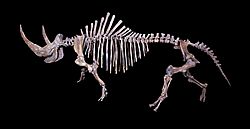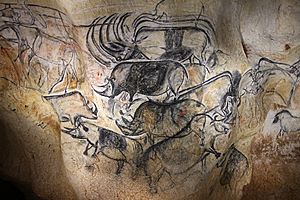Woolly rhinoceros facts for kids
Quick facts for kids Woolly RhinocerosTemporal range: Late Pleistocene
|
|
|---|---|
 |
|
| A woolly rhinoceros (Coelodonta antiquitatis) skeleton on display | |
| Conservation status | |
| Scientific classification | |
| Kingdom: | |
| Phylum: | |
| Class: | |
| Order: | |
| Family: | |
| Genus: |
†Coelodonta
Bronn, 1831
|
| Species: |
†C. antiquitatis
|
| Binomial name | |
| Coelodonta antiquitatis (Blumenbach, 1807)
|
|
The woolly rhinoceros (Coelodonta antiquitatis) was a huge mammal that looked a lot like the rhinos we see today, but it's now extinct. These amazing creatures lived across the cold, open lands of northern Eurasia during the Pleistocene epoch. This was a time of many ice ages, from about 1.8 million years ago until about 10,000 years ago.
Scientists recently found the oldest known woolly rhino fossil. It was discovered in the Himalayas on the cold Tibetan plateau and is about 3.6 million years old! This was during a time when the Earth was generally warmer. Experts believe these rhinos might have started there and then moved to other areas as the ice ages began.
Contents
What Did Woolly Rhinos Look Like?
Woolly rhinos were perfectly built for the cold weather. They had very thick, shaggy fur to keep them warm. Their ears were small, and their legs were short, which helped them lose less body heat. They also had a massive body, like a giant, furry tank!
Scientists have found many fossils of these ancient rhinos. They've even found well-preserved bodies frozen in the gravel of Siberia. These amazing discoveries give us a lot of information about what they looked like and how they lived.
Woolly Rhinos and Early Humans

Stone Age humans lived at the same time as woolly rhinos. These early humans actually hunted the rhinos for food and other resources. We know this because they drew pictures of these rhinos on cave walls about 30,000 years ago. These cave paintings are like ancient photographs, giving us even more clues about these large mammals.
Why Did Woolly Rhinos Disappear?
Woolly rhinos became extinct around 10,000 years ago, at the end of the last ice age. The main reason for their disappearance was likely the big change in climate. As the Earth warmed up, the vast grasslands and tundra where they lived began to shrink. Forests grew in their place, and the rhinos couldn't find enough of their preferred food.
Hunting by early humans might have also played a role, especially as their habitat changed. However, most scientists agree that climate change was the biggest factor in the woolly rhino's extinction.
Images for kids
-
Woolly rhinoceros, woolly mammoths, cave lions, and Equus lambei herd in late Pleistocene northern Spain, by Mauricio Antón
See also
 In Spanish: Rinoceronte lanudo para niños
In Spanish: Rinoceronte lanudo para niños









